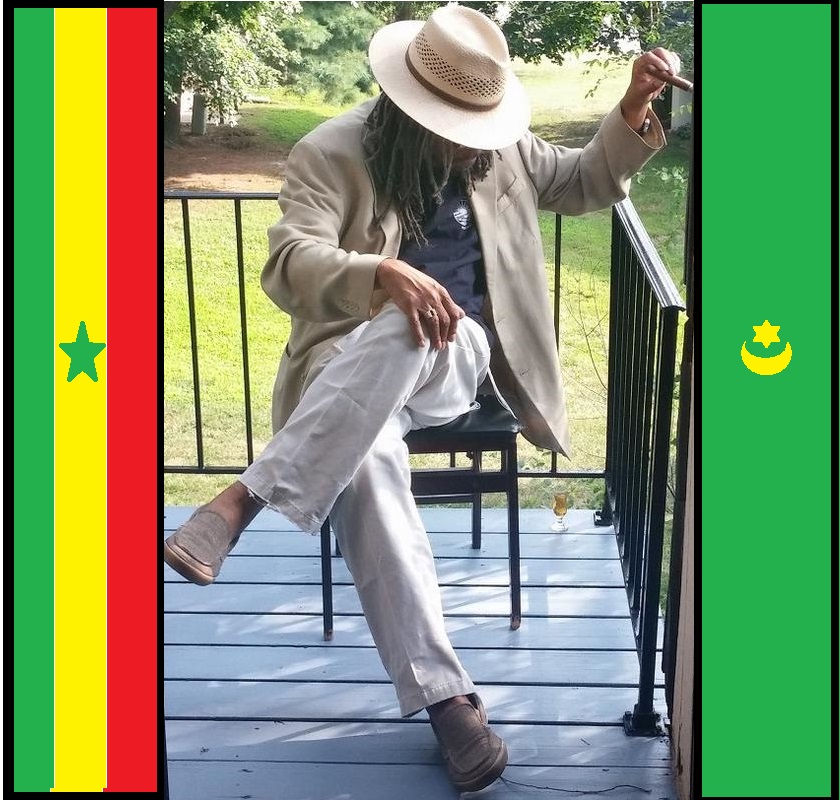|
|
Post by homeylu on May 8, 2010 7:49:49 GMT -5
The Ancient Nok Civilization The Nok civilization, existed as early as 1000 B.C., in what is now identified as Nigeria. The culture represents some of the earliest “evidence” of farming and iron smelting in Nigeria. Archaeologists have determined that most of the life size terracotta heads, were sculpted by hand, which is evidence of an advanced artistic society in West African that existed contemporaneously with Ancient Greece as well as Ancient Egypt and Kush as well as other North and East African civilizations. Far removed geographically from North and East African influence, it cannot be argued that cultures arriving from West Asia or Southern Europe had any direct influence on the advancement of this civilization, which makes it one of the most unique African civilizations during the first millennium B.C. This culture was thriving long before Herodotus began recording the history of the Northern portions of Africa, the area of the continent where his knowledge was limited to. Since no written evidence of this particular culture exists at the present, the history must be re-constructed based on the massive archaeological finds covering this era. The finely worked resilient sculptures indicate the technical advancement of this society. Most of the sculptures were constructed using a combination of locally available clay and gravel, fired and polished to a smooth finish. Each model individually sculpted to produce a distinctive variety of figures. The most striking aspect of the Nok figures, are the intricately designed hairstyles, and detailed jewelry which adorn the figures with variety, inventiveness, and beauty of their design is a beguiling record of cultivated devotion to body ornamentation. Evidence of life size heads  Nok Dignitary  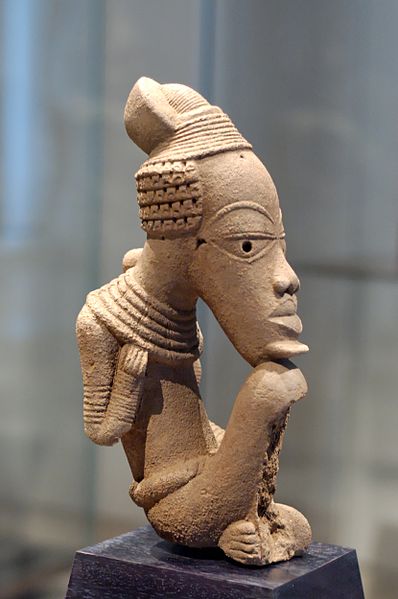 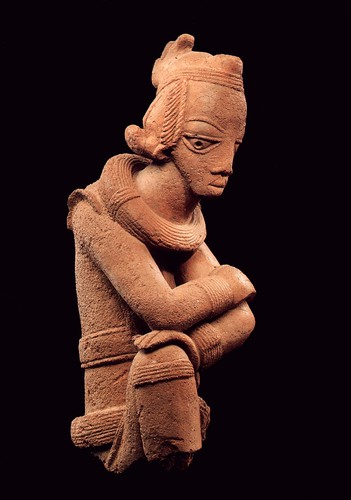 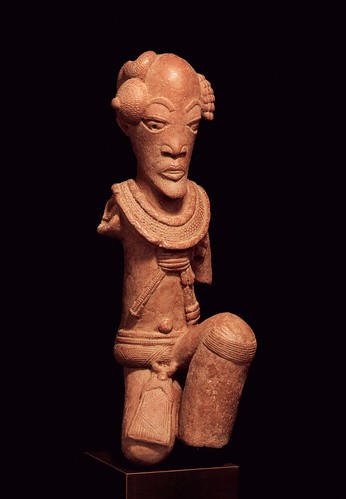 Similarities to the Ife sculptures 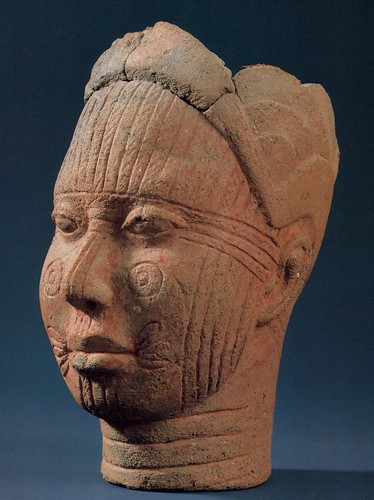 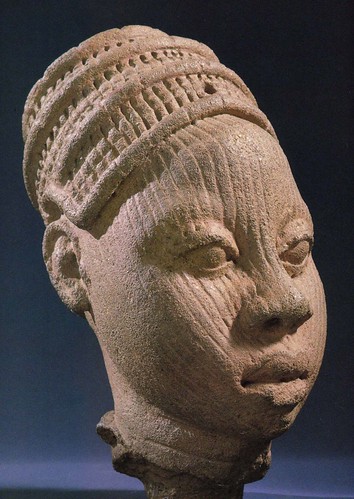 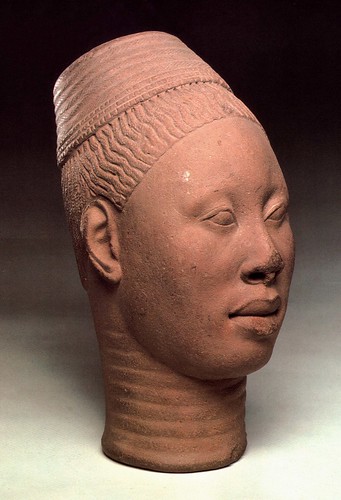 Map of Nok Civilization  Distribution of Nok Sites  |
|
|
|
Post by homeylu on May 8, 2010 8:00:25 GMT -5
Evidence of an agricultural society"At least parts of the original cultural deposits constitute today's farming ground. This agricultural soil and the layer beneath it (about 20-30cm thick) represent the former Nok horizon, indicated by scattered finds without any specific concentrations within the excavated areas. Below this horizon finds are restricted to pit-like structures dug into sterile ground. These pits are the only undisturbed features on the site. More than 7500 artefacts were excavated in total, marking out the assemblages of Ungwar Kura as the most substantial collection of Nok cultural materials scientifically excavated and recorded to date. The finds comprise pottery sherds, fragments of terracotta figurines and a few complete pieces, stone artefacts, mainly huge grinding stones and grinders, as well as ground stone axes. Of particular importance are iron objects, which represent not only the first iron tools from a clear Nok context, but also belong to the earliest finds of iron in West Africa. Large quantities of charred botanical remains help to reconstruct subsistence and environmental conditions. Archaeobotanical analyses are still in progress, but one of our first results is that pearl millet (Pennisetum glaucum) is consistently present in the cultural deposits of Ungwar Kura. Located in the Nigerian Middle Belt, the environment of the site is at present dominated by Guinea savannah with tall grasses and woodland vegetation. Guinea corn and New World cassava constitute the staple crops, whereas pearl millet only plays a minor role in cultivation. Our recent finds demonstrate that this had been quite different in the past." www.antiquity.ac.uk/ProjGall/kahlheber/index.htmlMost of the people were farmers. The Nok culture was an advanced culture for that time in Western Africa. Over time archeologists have found many artifacts from the Nok culture. The Nok people had a very advanced social system for that time. In the artifacts that the archeologist have found shows that the Nok people were very organized, because even thou they were farmers they had a very advanced social system. They knew how to smelt and forge iron. Nok's civilization was the earliest sub-Saharan civilization that produced life-sized Terracotta. The Nok culture was an Iron Age culture. In the evidences that the archeologists found, show that the people of the Nok culture were farmers and that they used iron to make better farming tools.
Sculpture in Louvre Museum

|
|
|
|
Post by homeylu on May 8, 2010 8:01:04 GMT -5
Video on the Nok Culture
|
|
|
|
Post by anansi on May 8, 2010 23:05:52 GMT -5
I think the Nok is an over looked civilization because it may well have been the ancestor to all of the later very urban civilizations that was to follow in the later centuries ..it is also too bad we don't even know what they called themselves..Btw I am searching for information on what their buildings may have looked like but came up empty..anyone with the info..give it up...please!!..but I am well to gamble that they looked much like the Benin architecture.
|
|
|
|
Post by homeylu on May 9, 2010 13:41:14 GMT -5
I'm trying to open horizons in studying other African civilizations, but as you can see, they don't receive much attention, because no one can argue about what "race" they belong to. When they discover an African civilization that they can't claim belonged to "caucasians" rather Europeans or Arabs, they have nothing to say.  Africans are most likely the earliest users of Iron smelting among other things. But little of this comes to light, because most discussion center around who was Black, and who was a Caucasoid. As far as their buildings, none were discovered so far. But we can imagine that they were probably of a similar structure "terracotta" since their statues indicates a mastery of the use this substance. They hypothesis the size of the civilization was approx 4000 people, small but advanced for their time. |
|
|
|
Post by anansi on May 9, 2010 21:25:16 GMT -5
I'm trying to open horizons in studying other African civilizations, but as you can see, they don't receive much attention, because no one can argue about what "race" they belong to. When they discover an African civilization that they can't claim belonged to "caucasians" rather Europeans or Arabs, they have nothing to say.  Africans are most likely the earliest users of Iron smelting among other things. But little of this comes to light, because most discussion center around who was Black, and who was a Caucasoid. As far as their buildings, none were discovered so far. But we can imagine that they were probably of a similar structure "terracotta" since their statues indicates a mastery of the use this substance. They hypothesis the size of the civilization was approx 4000 people, small but advanced for their time. Don't worry about the immediate response it is posted and someone will read it light bulbs will switch on in someones heads..keep posting. |
|
|
|
Post by truthteacher2007 on May 9, 2010 23:42:37 GMT -5
I'm trying to open horizons in studying other African civilizations, but as you can see, they don't receive much attention, because no one can argue about what "race" they belong to. When they discover an African civilization that they can't claim belonged to "caucasians" rather Europeans or Arabs, they have nothing to say.  Africans are most likely the earliest users of Iron smelting among other things. But little of this comes to light, because most discussion center around who was Black, and who was a Caucasoid. As far as their buildings, none were discovered so far. But we can imagine that they were probably of a similar structure "terracotta" since their statues indicates a mastery of the use this substance. They hypothesis the size of the civilization was approx 4000 people, small but advanced for their time. That's not true. Nok was founded by a branch of the Nordic peoples who fled Egypt after it was over run by the negros. Maybe this will help?  Nok was the first Sub Saharan civilization I discovered. It was quite a revelation to find out that in West Africa there was an Iron Age civilization of sophistication, quite different from the images I'd seen on T.V and movies. I remember in JR high my social studies teacher telling the class that civilization originated in the Fertile crescent and then spread north. Great fir his ego as he was jewish, but it left me looking at the map of Africa and wondering how come no civilizations arose there. Hiow I wish I had known back then what I know now. I stumbled upon Nok in a very old book called Lost Civilizations and it forever changed my mind about hopw I saw Africa below the Sahara. These were a people who went straight from the stone age to the Iron Age. A people who developed agriculture on their own and had a sophisticated system of social organization. There's no telling what remains to be discovered. One of the reasons why I wish people would stop acting as if Egypt were the be all and end all of African civilization. There is a great wealth of knowledge that is waiting to be discovered, but Egypt gets all the attention. I wonder if there have been any rescent discoveries. By the way Anansi, could you post some pictures of Benin Architecture? |
|
|
|
Post by anansi on May 10, 2010 2:44:05 GMT -5
I'm trying to open horizons in studying other African civilizations, but as you can see, they don't receive much attention, because no one can argue about what "race" they belong to. When they discover an African civilization that they can't claim belonged to "caucasians" rather Europeans or Arabs, they have nothing to say.  Africans are most likely the earliest users of Iron smelting among other things. But little of this comes to light, because most discussion center around who was Black, and who was a Caucasoid. As far as their buildings, none were discovered so far. But we can imagine that they were probably of a similar structure "terracotta" since their statues indicates a mastery of the use this substance. They hypothesis the size of the civilization was approx 4000 people, small but advanced for their time. That's not true. Nok was founded by a branch of the Nordic peoples who fled Egypt after it was over run by the negros. Maybe this will help?  Nok was the first Sub Saharan civilization I discovered. It was quite a revelation to find out that in West Africa there was an Iron Age civilization of sophistication, quite different from the images I'd seen on T.V and movies. I remember in JR high my social studies teacher telling the class that civilization originated in the Fertile crescent and then spread north. Great fir his ego as he was jewish, but it left me looking at the map of Africa and wondering how come no civilizations arose there. Hiow I wish I had known back then what I know now. I stumbled upon Nok in a very old book called Lost Civilizations and it forever changed my mind about hopw I saw Africa below the Sahara. These were a people who went straight from the stone age to the Iron Age. A people who developed agriculture on their own and had a sophisticated system of social organization. There's no telling what remains to be discovered. One of the reasons why I wish people would stop acting as if Egypt were the be all and end all of African civilization. There is a great wealth of knowledge that is waiting to be discovered, but Egypt gets all the attention. I wonder if there have been any rescent discoveries. By the way Anansi, could you post some pictures of Benin Architecture? Actually not really the oldest you see there was a civilization at Dar tachitt that goes back some 4000yrs B.C EARLY HISTORY
Before 2000 BC, what is today the southern Sahara was inhabited by significant numbers of herders and farmers. On the rocky promontories of the Tichitt-Walata (Birou) and Tagant Plateaus in modern day Mauritania, they built what are considered among the earliest known civilizations in western Africa. Composed of more than 400 stone masonry settlements, with clear street layouts, some settlements had m*filtered*ive surrounding walls while others were less fortified. In a deteriorating environment, where arable land and pasturage were at a premium, the population grew and relatively large-scale political organizations emerged - factors which no doubt explain the homogeneity of architecture, settlement patterns, and material culture (e.g., lithic and ceramic traditions). This agro-pastoral society traded in jewelry and semi-precious stones from distant parts of the Sahara and Sahel, while crafts, hunting, and fishing were also important economic pursuits. Their elites built funerary monuments for themselves over a period extending from 4000 to 1000 BC.
thenile.phpbb-host.com/phpbb/ftopic404.php  Also check out the Kintampo project thenile.phpbb-host.com/phpbb/ftopic787.phpI posted some Benin houses in a thread called African Arts and Architecture egyptsearchreloaded.proboards.com/index.cgi?board=pav&action=display&thread=126And I agree some folks just love their Blk /WHt dynamic don't they!! if whites or others are not involve why bother!!..  But don't worry whatever you have just put it out there. |
|
|
|
Post by homeylu on May 10, 2010 7:54:37 GMT -5
That's not true. Nok was founded by a branch of the Nordic peoples who fled Egypt after it was over run by the negros. Maybe this will help?  Adorable,  ;D You're correct, I am of the belief that there is still large areas of that huge continent that remain unearthed and undiscovered. It was only by "chance" that they discovered the Nok culture, I think they were mining in the area. (probably looking for minerals to exploit)  I always used to say, if you search you will find. We may discover a civilization more advanced and much older than Egypt, who knows. History is not as static as people tend to believe, it's being rewritten everyday, as new discoveries are made. This is something I found interesting about Iron Smelting in Africa from the Unesco website: " Iron technology did not come to Africa from western Asia via Carthage or Merowe as was long thought, concludes "Aux origines de la métallurgie du fer en Afrique, Une ancienneté méconnue: Afrique de l'Ouest et Afrique centrale". The theory that it was imported from somewhere else, which - the book points out - nicely fitted colonial prejudices, does not stand up in the face of new scientific discoveries, including the probable existence of one or more centres of iron-working in west and central Africa andthe Great Lakes area.. .......But the facts speak for themselves. Tests on material excavated since the 1980s show that iron was worked at least as long ago as 1500 BC at Termit, in eastern Niger, while iron did not appear in Tunisia or Nubia before the 6th century BC. At Egaro, west of Termit, material has been dated earlier than 2500 BC, which makes African metalworking contemporary with that of the Middle East......In fact, only in Africa do you find such a range of practices in the process of direct reduction ,and metal workers who were so inventive that they could extract iron in furnaces made out of the trunks of banana trees," says Hamady Bocoum, one of the authors.
This ingenuity was praised in the early 19th century by the Tunisian scholar Mohamed el-Tounsy, who told of travelling in Chad and Sudan and coming across spears and daggers made "with the skill of the English" and iron piping with "bends and twists like some European pipes, but more elegant and graceful and shining so brightly they seem to be made of silver."
portal.unesco.org/en/ev.php-URL_ID=3432&URL_DO=DO_TOPIC&URL_SECTION=201.html |
|
|
|
Post by homeylu on May 10, 2010 8:10:10 GMT -5
Actually not really the oldest you see there was a civilization at Dar tachitt that goes back some 4000yrs B.C Which is why I was careful to state "One" of the oldest, as I am aware of the Dar Tachitt civilization as well. But you and I both know how they like to divide Africa up into sections, i.e. North Africa, East Africa, Sub Sahara Africa, etc., and civilizations all across the continent are now being discovered. I think social scientists must always leave room for more discoveries, which is why most would claim "oldest discovered" so far, rather than emphatically stating that any civilization is the oldest, like when they found the pottery in the Sahara dated 10,000 years ago, made them rethink how early agriculture began on the continent, "without outside influence." (Have to throw that in there  ) Some one designed and posted a map of the various Pre-colonial Kingdoms which existed in Africa, and uploaded it to Wikipedia. It appears that large Kingdoms existed all across the continent. Even a few like the Garamante civilization are missing from this map, just imagine how many more have not been discovered yet. 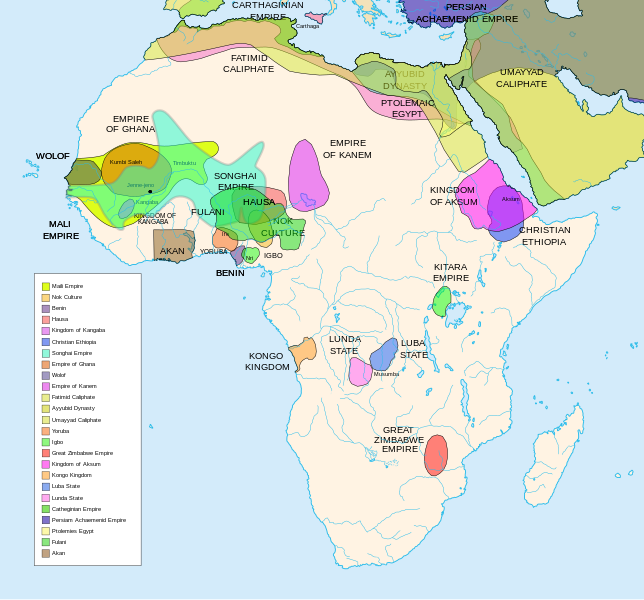 |
|
|
|
Post by anansi on May 10, 2010 8:47:31 GMT -5
Actually not really the oldest you see there was a civilization at Dar tachitt that goes back some 4000yrs B.C Which is why I was careful to state "One" of the oldest, as I am aware of the Dar Tachitt civilization as well. But you and I both know how they like to divide Africa up into sections, i.e. North Africa, East Africa, Sub Sahara Africa, etc., and civilizations all across the continent are now being discovered. I think social scientists must always leave room for more discoveries, which is why most would claim "oldest discovered" so far, rather than emphatically stating that any civilization is the oldest, like when they found the pottery in the Sahara dated 10,000 years ago, made them rethink how early agriculture began on the continent, "without outside influence." (Have to throw that in there  ) Some one designed and posted a map of the various Pre-colonial Kingdoms which existed in Africa, and uploaded it to Wikipedia. It appears that large Kingdoms existed all across the continent. Even a few like the Garamante civilization are missing from this map, just imagine how many more have not been discovered yet.  My response was to Truthteacher I know you know as you are upon the Saharan complex..but that's also another area that needs looking into for that would put Dar Tachitt in at the same age as the old and pre-dynastic phase of KMT...4000 B.C??actually that's more like Ta-Seti rather than Kmt proper. |
|
|
|
Post by Tukuler al~Takruri on May 10, 2010 13:01:10 GMT -5
The civilization of the Awkar Depression region goes back to 2000 BCE
which was 4000 years ago. Of course there were cultural preludes that
built up to the full blown civilization. They would be more contemporary
to old TaSeti.
|
|
jari
Scribe
 
Posts: 289
|
Post by jari on May 12, 2010 5:11:03 GMT -5
I'm trying to open horizons in studying other African civilizations, but as you can see, they don't receive much attention, because no one can argue about what "race" they belong to. When they discover an African civilization that they can't claim belonged to "caucasians" rather Europeans or Arabs, they have nothing to say.  Africans are most likely the earliest users of Iron smelting among other things. But little of this comes to light, because most discussion center around who was Black, and who was a Caucasoid. As far as their buildings, none were discovered so far. But we can imagine that they were probably of a similar structure "terracotta" since their statues indicates a mastery of the use this substance. They hypothesis the size of the civilization was approx 4000 people, small but advanced for their time. Actually in my opinion the problem is not race it really boils down to the amount of available information. As Truthteacher pointed out scholarship lends toward the so called Middle East and Egypt and of course Europe. Other than a few internet articles one would be hard pressed to find info on the Nok.(as well as many other African cultures). My guess is that if these people had enough spare time to make such advanced works of art such as the ones found, then they must have controlled a well organized and powerful(as well as wealthy) society. Art is not something that is easy to do, esp. sculpture. It takes time-years of practice, materials(Terracotta) and a master. To me there had to be a civilization of some sort predating Nok that reached its zenith in the arts during the time of the scupture. |
|
|
|
Post by anansi on May 12, 2010 9:18:19 GMT -5
I agree to some extent that scholars tend to focus away from Africa south of the desert to else-where and some African nations would rather spend money on the here and now and not the past but still if they don't spend the money and the time on their heritage and show-case it to the world then they do themselves a disservice...look Nigeria is not exactly broke("it ain't Greece") and country that actively show-case their cultural heritage wins.. $$ Mali is just now trying to make a come back based off it's Heritage no one at this day and age should ask what's a Nok??
|
|
|
|
Post by homeylu on May 12, 2010 9:58:04 GMT -5
As much as Hawass is criticized for his "eurocentric" views, I must admit that he does take considerable measures to protect Egypt's antiquities and keep them in their rightful place. Unfortunately this is not taking place in Nigeria. Not only are many of the Nok sculptures found more in museums outside of Africa, like the one I posted above. You can also find them being auctioned in art galleries. I find rare art like this to be priceless, and should preserved and kept in museums within the country. They can allow exhibitions to take place in other cities, but after-wards, it should come back home. This really saddens me.
|
|





























 ;D
;D  )
) 
